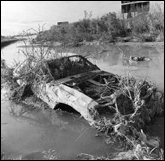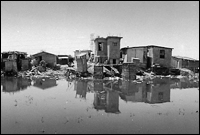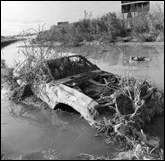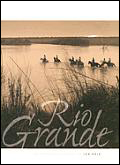The week before I sat down to read Rio Grande, a thick new anthology about the famed river edited by Texas scribe Jan Reid, a strange sight appeared on the actual Rio Grande outside the border town of Eagle Pass, Texas. A fiberglass statue of Jesus was discovered grounded on a sandbar in the river, drawing faithful visitors from both sides of the border to its river-stained robes. Admittedly, little connects the literature of the river and the religious relic that appeared there this fall — except, perhaps, this: the contributors to the book and the worshipers of the statue share the conviction that the river needs a savior.
That’s one conclusion made crystal clear by this literary-minded collection, which pulls together a kaleidoscope of sources into a nearly definitive volume focused not just on the ecology of the Rio Grande but also its history and the cultures that have relied upon it for the last 15,000 years, from natives to conquistadors, cowboys to smugglers, farmers to migrant workers.

Swinging over troubled waters.
Photo: James Evans,
courtesy of U. of Texas Press.
Even if you’ve never picked up a book on the Rio Grande (known as the Rio Bravo del Norte in Mexico), you’re probably aware that something has been amiss with the river and its surroundings for quite a while. In 2001, the region’s water crisis earned a kind of ecological exclamation point when, for the first time on record, the 1,885-mile river ceased to reach the Gulf of Mexico, its ultimate destination. Drought, irrigation demands, and invasive plant species such as salt cedar had literally sucked the river dry, so that when it reached Boca Chica (“little mouth”), the stream no longer had the volume to push through the last hundred or so feet of sand. Heavy rains this year have helped restore the flow, but, as Reid writes in the epilogue, “We have let the Rio Grande become the river that can no longer find its way to the sea.”
My own relationship to the river has been both professional and recreational. In 2002, I drove to Boca Chica, like Reid, to see where the water turns brackish after passing through a tangle of exotic water hyacinth and finally reaches the Gulf of Mexico. I’ve interviewed epidemiologists and health officials concerning the impact of industrial and residential effluent on valley communities, which suffer high rates of birth defects and other unexplained health maladies probably tied to water quality. I’ve hiked the deep canyons of Big Bend National Park, where the stream dries to a trickle during the summer, and ridden in now-forbidden rowboats across the water in wintertime to enjoy home-cooked enchiladas and cheap beer in the dusty towns of northern Mexico. I’m grateful to have had those experiences, because after reading this book, I’m impressed that the river has any life left in it at all.

Car 54, where are you?
Photo: Earl Nottingham,
courtesy of U. of Texas Press.
And yet Rio Grande is no mere compendium of complaints about how humanity has harmed the “great” or “fierce” or “large” river (depending on who’s translating which name). Rather, it’s a sampling of stories from communities that span both sides of the boundary water and its length from the Rocky Mountains of Colorado to beaches at Boca Chica. Reaching back in time, the book includes characters such as the wandering 16th century conquistador Cabeza de Vaca, Mexican revolutionary Pancho Villa, and a host of not-so-famous Rio Grande fixtures. The book also touches on contemporary politics, including the North American Free Trade Agreement, Mexico’s current water debt to the United States (which remains a sticking point between President Bush and his Mexican counterpart Vicente Fox), and the increased militarization of the border after Sept. 11, 2001.
One notable early chapter comes from crusading journalist John Reed, who covered the Mexican Revolution in 1914, some five years before embarking for revolutionary Russia. In a depressing scene with distinct contemporary reverberations, Reed describes his experience crossing the border to cover the conflict, and the experience of travelers headed in the opposite direction. “Along the main street passed an unbroken procession of sick, exhausted, starving people, driven from the interior by fear of the approaching rebels over the most terrible desert in the world,” he writes. “Then they passed on to the river, and on the American side they had to run the gauntlet of the United States customs and immigration officials and the Army Border Patrol, who searched them for arms.”
As befits an anthology about a river, dipping in and out of this book at different points rewards the reader with different views of the water, the people, and the land. In addition to Reed and Reid (who recently coauthored The Hammer, a biography of House Majority Leader Tom DeLay), Rio Grande offers voices from the Lone Star state, sundry corners of the Southwestern borderlands, and beyond. Included are excerpts from novelists John Nichols’ The Milagro Beanfield War and Larry McMurtry’s Lonesome Dove, as well as contributions from Reid’s journalistic contemporaries, including GQ writer-at-large Robert Draper and Atlantic Monthly contributor William Langewiesche, the noted Chicana writers Gloria Anzaldua and Cecilia Balli, and others.

Shack treatment.
Photo: Alan Pogue,
courtesy of U. of Texas Press.
In addition to these diverse voices, Rio Grande makes excellent use of black-and-white images taken by a variety of photographers, including Ansel Adams and other well-known shutterbugs associated with the region. But rather than rely on the Sierra Club strategy of sparking our sympathies with idealized landscapes, Reid mixes in many photos that give a clear sense of the often difficult life along the river. “It is a broken river now, overused, abused, and in peril,” Reid writes. “Yet still it glows emerald-like in a collective imagination. And that mystique is its best hope for salvation.”
That’s a nice sentiment, but it also suggests the main problem with Rio Grande, which studiously avoids prescribing changes in the management of the river. The book addresses ecological problems up and down the Rio Grande, but there’s nary a hint of a solution in sight. Like the unfortunate lack of an index, this absence leaves the reader at a loss for how, exactly, to navigate the text. Rio Grande offers a poetic tribute to cultures and communities threatened and extinguished — but the river is still pressing onward, however meagerly, and thus we might expect the book to be more than just a eulogy. Still, Rio Grande helps remind us what’s at stake, and that may be inspiration enough.



